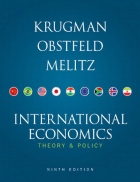




Mã tài liệu: 643725
Số trang: 736
Định dạng: pdf
Dung lượng file: 8,256 Kb
Chuyên mục: Kinh tế
We are delighted to welcome Marc Melitz of Harvard University to our author team beginning in this ninth edition of International Economics: Theory & Policy.We have thoroughly updated the content and extensively revised several chapters. These revisions respond both to users’ suggestions and to some important developments on the theoretical and practical sides of international economics. The most far-reaching changes are the following: Chapter 4, Specific Factors and Income Distribution In response to popular demand, this chapter reinstates the specific factors model of trade, which allows for mobile, general-purpose factors of production as well as factors that are unable to move between different industries. Aside from providing a simple and intuitively appealing account of why countries trade, the model is a useful tool for illustrating how trade creates clear losers as well as winners. This revised chapter also covers international labor movements and immigration within a theoretical framework based on the specific factors model. Chapter 5, Resources and Trade: The Heckscher-Ohlin Model This edition offers expanded coverage of the effects on wage inequality of North-South trade, of technological change, and of outsourcing. Chapter 6, The Standard Trade Model This chapter now contains our model of intertemporal trade. Global equilibrium is analyzed using the relative supply–relative demand framework rather than offer curves. Chapter 8, Firms in the Global Economy: Export Decisions, Outsourcing, and Multinational Enterprises The second half of this chapter is entirely new and covers important recent research advances on the role of firms in international trade. Among the topics we feature are new models with performance differences across firms, discussion of how economic integration generates both winners and losers among firms in the same industry, and the productivity gains from economic integration. The chapter also develops models of multinational firms and of outsourcing. Chapter 9, The Instruments of Trade Policy This chapter features an updated treatment of the effects of trade restrictions on United States firms. Chapter 13, National Income Accounting and the Balance of Payments The discussion of balance of payments accounting has been thoroughly revised to reflect the recommendations in the sixth edition of the IMF’s Balance of Payments and International Investment Position Manual.These conventions have been widely adopted internationally and will be phased in over the next few years in the official United States statistics on international transactions. Chapter 18, Fixed Exchange Rates and Foreign Exchange Intervention The recent financial crisis has led a number of major central banks to lower target interest rates to, or close to, the zero lower bound. This chapter integrates the case of the liquidity trap into the development of the DD-AAmodel, thereby allowing the instructor to introduce the topic of “unconventional” monetary policies. Chapter 19, International Monetary Systems: An Historical Overview This new chapter merges streamlined versions of prior Chapters 18 and 19, which covered, respectively, pre-1973 and post-1973 international monetary history. The chapter takes the open-economytrilemma, previously introduced in Chapter 21, as a guiding framework for understanding the evolution of the international monetary system since the late 19th century. The chapter features coverage of the macroeconomic antecedents and consequences of the global financial crisis of 2007–2009. Chapter 21, Financial Globalization: Opportunity and Crisis The chapter contains extended discussion of shadow banking systems, moral hazard, and financial aspects of the 2007–2009 global crisis. xxii Preface In addition to these structural changes, we have updated the book in other ways to maintain current relevance. Thus we examine linkages between trade and unemployment (Chapter 4); we review recent trends in foreign direct investment (Chapter 8); we discuss the carry trade in light of uncovered interest parity (Chapter 14); we describe the euro zone sovereign debt crisis that started in 2010 (Chapter 20); and we explain how the financial crisis of 2007–2009 gave rise to a global “dollar shortage,” leading central banks to establish an unprecedented network of currency swap lines (Chapter 21)
Những tài liệu gần giống với tài liệu bạn đang xem
📎 Số trang: 27
👁 Lượt xem: 498
⬇ Lượt tải: 16
📎 Số trang: 79
👁 Lượt xem: 173
⬇ Lượt tải: 11
📎 Số trang: 90
👁 Lượt xem: 149
⬇ Lượt tải: 14
Những tài liệu bạn đã xem
 International Economics
We are delighted to welcome Marc Melitz of Harvard University to our author team beginning in this ninth edition of International Economics: Theory & Policy.We have thoroughly updated the content and extensively revised several chapters. These
pdf Đăng bởi
phamvanthanh.hn.vn@gmail.com
International Economics
We are delighted to welcome Marc Melitz of Harvard University to our author team beginning in this ninth edition of International Economics: Theory & Policy.We have thoroughly updated the content and extensively revised several chapters. These
pdf Đăng bởi
phamvanthanh.hn.vn@gmail.com